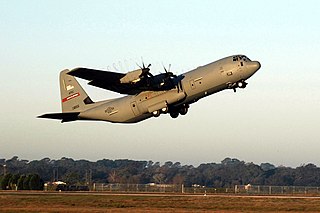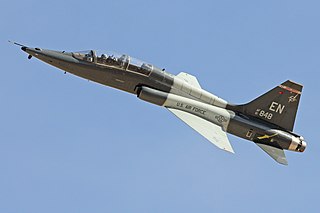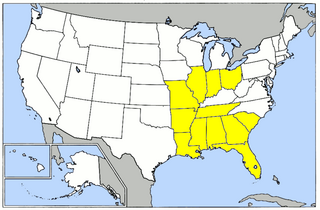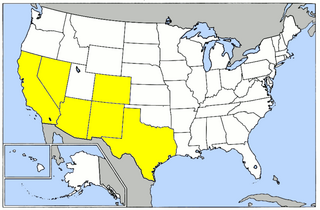
Williams Air Force Base is a former United States Air Force (USAF) base, located in Maricopa County, Arizona, east of Chandler, and about 30 miles (48 km) southeast of Phoenix. It is a designated Superfund site due to a number of soil and groundwater contaminants.

Scott Air Force Base is a United States Air Force base in St. Clair County, Illinois, near Belleville and O'Fallon, 17 miles east-southeast of downtown St. Louis. Scott Field was one of thirty-two Air Service training camps established after the United States entered World War I in April 1917. It is headquarters of Air Mobility Command (AMC), and is also the headquarters of the U.S. Transportation Command, a Unified Combatant Command that coordinates transportation across all the services.

The Second Air Force is a USAF numbered air force responsible for conducting basic military and technical training for Air Force enlisted members and non-flying officers. In World War II the CONUS unit defended the Northwestern United States and Upper Great Plains regions and during the Cold War, was Strategic Air Command unit with strategic bombers and missiles. Elements of Second Air Force engaged in combat operations during the Korean War; Vietnam War, as well as Operation Desert Storm.

The Fourth Air Force is a numbered air force of the Air Force Reserve Command (AFRC). It is headquartered at March Air Reserve Base, California.

Keesler Air Force Base is a United States Air Force base located in Biloxi, a city along the Gulf Coast in Harrison County, Mississippi, United States. The base is named in honor of aviator 2d Lt Samuel Reeves Keesler Jr., a Mississippi native killed in France during the First World War. The base is home of Headquarters, Second Air Force and the 81st Training Wing of the Air Education and Training Command (AETC).

Sheppard Air Force Base is a United States Air Force base located five miles (8.0 km) north of the central business district of Wichita Falls, in Wichita County, Texas, United States. It is the largest training base and most diversified in Air Education and Training Command. The base is named in honor of Texas Senator John Morris Sheppard, a supporter of military preparations before World War II.

Chanute Air Force Base is a decommissioned United States Air Force facility, located in Champaign County, Illinois, south of and adjacent to Rantoul, Illinois, about 130 miles (210 km) south of Chicago. Its primary mission throughout its existence was Air Force technical training. Chanute Field was established on 21 May 1917, being one of thirty-two Air Service training camps established after the United States entry into World War I.

The 50th Air Division is an inactive United States Air Force unit. Its last assignment was with Third Air Force at Pope Field, North Carolina. It was inactivated on 31 July 1946.

The 370th Air Expeditionary Wing (AEW) is a provisional United States Air Force unit assigned to United States Air Forces Central, which may activate or inactivate it at any time. The unit was last stationed in Iraq, and was likely inactivated in 2011 as part of the United States pullout of forces.

The 100th Fighter Squadron is a unit of the Alabama Air National Guard 187th Fighter Wing located at Dannelly Field, Alabama. The 100th is equipped with the General Dynamics F-16C+ Fighting Falcon.

The 911th Air Refueling Squadron is part of the 916th Air Refueling Wing at Seymour Johnson AFB, North Carolina. The squadron is the Air Force's very first active duty squadron that is under the command of a reserve wing. In October 2016, the 911th, formerly geographically separated from the 6th Air Mobility Wing at MacDill AFB, FL and operated as the active duty associate to the 916th Air Refueling Wing, became the first "I-Wing" or Integrated Wing.

The United States Army Air Forces during World War II had major subordinate Commands below the Air Staff level. These Commands were organized along functional missions. One such Command was the Flying Training Command (FTC). It began as Air Corps Flying Training Command on 23 January 1942, was redesignated Army Air Forces Flying Training Command (AAFTC) on 15 March 1942, and merged with Army Air Forces Technical Training Command to become Army Air Forces Training Command on 31 July 1943. Continuing service after the war, it was redesignated Air Training Command on 1 July 1946. During the consolidation of Air Force Major Commands in the retrenchment of the 1990s, Air Training Command assumed control of Air University and became Air Education and Training Command on 1 July 1993—today's Air Education and Training Command (AETC), which celebrated its 75th anniversary 23 January 2017. see the Lineage and honors statement for AETC.

Greenville Air Force Base is a former United States Air Force base in Greenville, Mississippi. It was closed as a military installation in December 1966 and redeveloped into Mid-Delta Regional Airport.

The United States Army Air Forces was the major land-based aerial warfare service component of the United States Army and de facto aerial warfare service branch of the United States during and immediately after World War II (1941–1945). It was created on 20 June 1941 as successor to the previous United States Army Air Corps and is the direct predecessor of the United States Air Force, today one of the six armed forces of the United States. The AAF was a component of the United States Army, which on 2 March 1942 was divided functionally by executive order into three autonomous forces: the Army Ground Forces, the United States Army Services of Supply, and the Army Air Forces. Each of these forces had a commanding general who reported directly to the Army Chief of Staff.

The 3d Special Operations Squadron flies MQ-1 Predator Remotely Piloted Aircraft and is currently located at Cannon Air Force Base, New Mexico. The squadron is under the command of the Air Force Special Operations Command.

Army Air Forces Eastern Flying Training Command (EFTC) was a unit of the United States Army Air Forces. It was assigned to the Army Air Forces Training Command, stationed at Maxwell Field, Alabama. It was inactivated on 15 December 1945.

The Western Flying Training Command (WFTC) was a command of the United States Army Air Forces. It was assigned to the Army Air Forces Training Command, stationed at Santa Ana Army Air Base, California. It was inactivated on 1 November 1945.

Flying Division, Air Training Command, was a training formation of the United States Air Force. The unit was established in 1926 as the Air Corps Training Center to be the primary pilot training center for the Air Corps. It was reorganized into one of three training commands created by the Office of the Chief of the Air Corps in 1940 to accommodate the large number of air cadets being recruited as a result of the expansion of the corps after the fall of France. During World War II, thousands of cadets attended various flight schools throughout the Central United States being trained as pilots for fighters, bombers and transports. It also trained the navigators, bombardiers and gunners necessary for the bombers to attack enemy targets in the combat areas overseas. After World War II, it became the primary pilot and aircrew training unit of the United States Air Force Air Training Command.

Technical Division, Air Training Command is an inactive United States Air Force unit. It was assigned to the Air Training Command, stationed at Scott Air Force Base, Illinois. It was inactivated on 14 November 1949.

Western Technical Training Command was a command of the United States Army Air Forces. It was assigned to the Army Air Forces Training Command, and stationed at Denver, Colorado throughout its existence. It was inactivated on 15 October 1945.





















